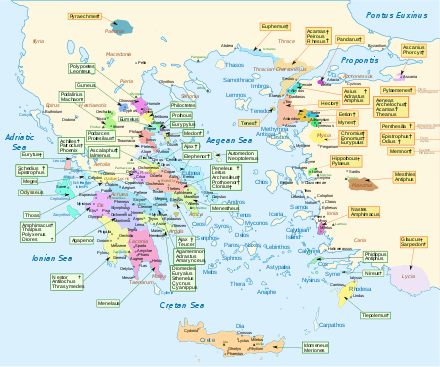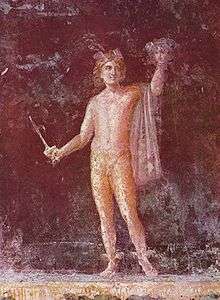Mycenae
Mycenae (/maɪˈsiːniː/ my-SEE-nee;[2] Ancient Greek: Μυκῆναι or Μυκήνη, Mykē̂nai or Mykḗnē) is an archaeological site near Mykines in Argolis, north-eastern Peloponnese, Greece. It is located about 120 kilometres (75 miles) south-west of Athens; 11 kilometres (7 miles) north of Argos; and 48 kilometres (30 miles) south of Corinth. The site is 19 kilometres (12 miles) inland from the Saronic Gulf and built upon a hill rising 900 feet (274 metres) above sea level.[3]
Μυκῆναι Μυκήνη Μυκήνες | |
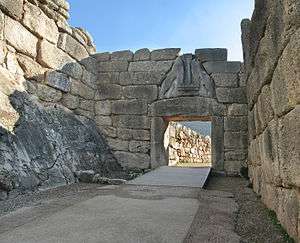 The Lion Gate at Mycenae, the only known monumental sculpture of Bronze Age Greece | |
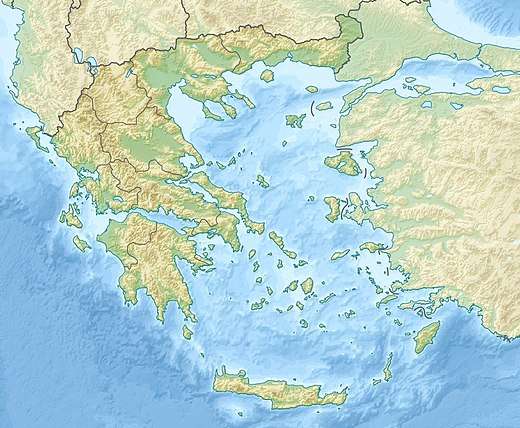 Shown within Greece | |
| Location | Argolis, Greece |
|---|---|
| Coordinates | 37°43′49″N 22°45′27″E |
| Type | Settlement |
| History | |
| Founded | 1350-1200 BC[1] |
| Periods | Bronze Age |
| Cultures | Mycenaean Greece |
| Events | Late Bronze Age collapse |
| Site notes | |
| Archaeologists | Francesco Grimani |
| Condition | Partly buried |
| Official name | Archaeological Sites of Mycenae and Tiryns |
| Type | Cultural |
| Criteria | i, ii, iii, iv, vi |
| Designated | 1999 (23rd session) |
| Reference no. | 941 |
| State Party | Greece |
| Region | Europe and North America |
In the second millennium BC, Mycenae was one of the major centres of Greek civilization, a military stronghold which dominated much of southern Greece, Crete, the Cyclades and parts of southwest Anatolia. The period of Greek history from about 1600 BC to about 1100 BC is called Mycenaean in reference to Mycenae. At its peak in 1350 BC, the citadel and lower town had a population of 30,000 and an area of 32 hectares.[4]
The first correct identification of Mycenae in modern literature was during a survey conducted by Francesco Grimani, commissioned by the Provveditore Generale of the Kingdom of the Morea in 1700,[5] who used Pausanias's description of the Lion Gate to identify the ruins of Mycenae.[6][7][8]
Etymology
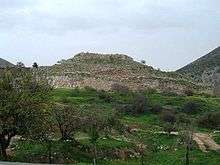
The earliest written form of the name is Mykḗnē (Μυκήνη), which is found in Homer.[9] The reconstructed Mycenaean Greek name of the site is 𐀘𐀏𐀙𐀂 (mu-ka-nai), which has the form of a plural like Athḗnai. The change of ā to ē in more recent versions of the name is the result of a well-known sound change in later Attic-Ionic.
The citadel was built by Greeks, the name Mykḗnai (or Mycenaean Greek Mukánai) is thought to be Greek, The name "Mycenae" is derived from the Greek word mykēs (μύκης, "mushroom"). Thus, Pausanias ascribes the name to the legendary founder Perseus, who was said to have named it either after the cap (mykēs) of the sheath of his sword, or after a mushroom he had plucked on the site.[10]
History
Neolithic Age
Mycenae, an acropolis site, was built on a hill 900 feet (274 metres) above sea level, some 19 kilometres (12 miles) inland from the Gulf of Argolis. Situated in the north-east corner of the Argive plain, it easily overlooked the whole area and was ideally positioned to be a centre of power, especially as it commanded all easy routes to the Isthmus of Corinth. Besides its strong defensive and strategic position, it had good farmland and an adequate water supply.[3] There are only faint traces of Neolithic settlement on the site although it was continuously occupied from the Early Neolithic (EN; c. 5000–c. 4000 BC) through the Early Helladic (EH; c. 3200–c. 2000 BC) and Middle Helladic (MH; c. 2000–c. 1550 BC) periods. EN Rainbow Ware constitutes the earliest ceramic evidence discovered so far.[11]
Early and Middle Bronze Age
The population had grown considerably by the Middle Helladic. As elsewhere, a dominant Cretan influence prevailed from c. 1600 BC, the first evidence of this coming from the shaft graves discovered in 1876 by Heinrich Schliemann.[3] Schliemann's shaft graves came to be known as Circle A to distinguish them from the Circle B graves which were found at a later date, although Circle B are the earlier graves dated c. 1650 BC to c. 1550 BC and entirely within MHIII. Circle A is dated to the sixteenth century BC including the transition from Middle to Late Helladic IA (LHIA; c. 1550–c. 1500 BC).[3] The contents of Circle B are less wealthy than those of Circle A.[12]
Pottery material spanning the entire Early Helladic was discovered 1877–78 by Panagiotis Stamatakis at a low depth in the sixth shaft grave in Circle A. Further EH and MH material was found beneath the walls and floors of the palace, on the summit of the acropolis, and outside the Lion Gate in the area of the ancient cemetery.[13] An EH–MH settlement was discovered near a fresh-water well on top of the Kalkani hill south-west of the acropolis.[13] The first burials in pits or cist graves manifest in MHII (c. 1800 BC) on the west slope of the acropolis, which was at least partially enclosed by the earliest circuit wall.[13]
Late Bronze Age
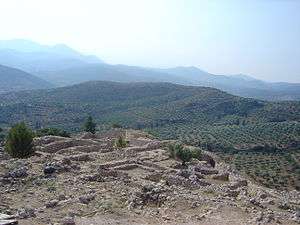
In the absence of documents and objects that can be precisely dated, events at Mycenae can only be dated relatively within the constraints of Helladic chronology which relies on categorisation of stratified material objects, mainly pottery, within an agreed historical framework. Mycenae developed into a major power during LHI (c. 1550–c. 1450 BC) and is believed to have become the main centre of Aegean civilisation through the fifteenth century to the extent that the two hundred years from c. 1400 BC to c. 1200 BC (encompassing LHIIIA and LHIIIB) are known as the Mycenaean Age. The Minoan hegemony was ended c. 1450 and there is evidence that Knossos was occupied by Mycenaeans until it too was destroyed c. 1370 BC. From then on, Mycenaean expansion throughout the Aegean was unhindered until the massive disruption of society in the first half of the twelfth century (LHIIIC) which ended Mycenaean civilisation and culminated in the destruction of Mycenae itself c. 1150 BC.
Late Helladic I (LHI; c. 1550–c. 1450 BC)
Outside the partial circuit wall, Grave Circle B, named for its enclosing wall, contained ten cist graves in Middle Helladic style and several shaft graves, sunk more deeply, with interments resting in cists. Richer grave goods mark the burials as possibly regal. Mounds over the top contained broken drinking vessels and bones from a repast, testifying to a more than ordinary farewell.[14] Stelae surmounted the mounds.[15]
A walled enclosure, Grave Circle A, included six more shaft graves, with nine female, eight male, and two juvenile interments. Grave goods were more costly than in Circle B. The presence of engraved and inlaid swords and daggers, with spear points and arrowheads, leave little doubt that warrior chieftains and their families were buried here. Some art objects obtained from the graves are the Silver Siege Rhyton, the Mask of Agamemnon, the Cup of Nestor, and weapons both votive and practical.
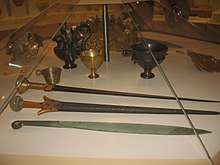
Late Helladic II (LHII; c. 1450–c. 1400 BC)
Alan Wace divided the nine tholos tombs of Mycenae into three groups of three, each based on architecture. His earliest – the Cyclopean Tomb, Epano Phournos, and the Tomb of Aegisthus – are dated to LHIIA.
Burial in tholoi is seen as replacing burial in shaft graves. The care taken to preserve the shaft graves testifies that they were by then part of the royal heritage, the tombs of the ancestral heroes. Being more visible, the tholoi all had been plundered either in antiquity, or in later historic times.
Late Helladic III (LHIII; c. 1400–c. 1050 BC)
At a conventional date of 1350 BC, the fortifications on the acropolis, and other surrounding hills, were rebuilt in a style known as Cyclopean because the blocks of stone used were so massive that they were thought in later ages to be the work of the one-eyed giants known as the Cyclopes.[16] Within these walls, much of which can still be seen, successive monumental palaces were built. The final palace, remains of which are currently visible on the acropolis of Mycenae, dates to the start of LHIIIA:2. Earlier palaces must have existed, but they had been cleared away or built over.
The construction of palaces at that time with a similar architecture was general throughout southern Greece. They all featured a megaron, or throne room, with a raised central hearth under an opening in the roof, which was supported by four columns in a square around the hearth. A throne was placed against the center of a wall to the side of the hearth, allowing an unobstructed view of the ruler from the entrance. Frescos adorned the plaster walls and floor.

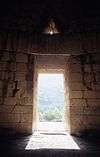
The room was accessed from a courtyard with a columned portico. A grand staircase led from a terrace below to the courtyard on the acropolis.
In the temple built within the citadel, a scarab of Queen Tiye of Egypt, who was married to Amenhotep III, was placed in the Room of the Idols alongside at least one statue of either LHIIIA:2 or B:1 type. Amenhotep III's relations with m-w-k-i-n-u, *Mukana, have corroboration from the inscription at Kom al-Hetan - but Amenhotep's reign is thought to align with late LHIIIA:1. It is likely that Amenhotep's herald presented the scarab to an earlier generation, which then found the resources to rebuild the citadel as Cyclopean and then, to move the scarab here.
Wace's second group of tholoi are dated between LHIIA and LHIIIB: Kato Phournos, Panagia Tholos, and the Lion Tomb. The final group, Group III: the Treasury of Atreus, the Tomb of Clytemnestra and the Tomb of the Genii, are dated to LHIIIB by a sherd under the threshold of the Treasury of Atreus, the largest of the nine tombs. Like the Treasury of Minyas at Orchomenus the tomb had been looted of its contents and its nature as funerary monument had been forgotten. The structure bore the traditional name of "Treasury".
The pottery phases on which the relative dating scheme is based (EH, MH, LH, etc.) do not allow very precise dating, even augmented by the few existing C-14 dates due to the tolerance inherent in these. The sequence of further construction at Mycenae is approximately as follows. In the middle of LHIIIB, around 1250 BC or so, the Cyclopean wall was extended on the west slope to include Grave Circle A.[18] The main entrance through the circuit wall was made grand by the best known feature of Mycenae, the Lion Gate, through which passed a stepped ramp leading past circle A and up to the palace. The Lion Gate was constructed in the form of a "Relieving Triangle" in order to support the weight of the stones. An undecorated postern gate also was constructed through the north wall.
One of the few groups of excavated houses in the city outside the walls lies beyond Grave Circle B and belongs to the same period. The House of Shields, the House of the Oil Merchant, the House of the Sphinxes, and the West House. These may have been both residences and workshops.
Citadel Facts and Figures
Circuit length: 1,105 metres (3,625 ft)
Preserved height: up to 12.5 metres (41 ft)
Width: 7.5-17M
Minimum stone required: 145,215 Cu.M or 14,420 average stones (10 tons)
Time to move 1 Block using men: 2.125 days
Time to move all Blocks using men: 110.52 years
Time to move 1 Block using oxen: 0.125 days
Time to move all Blocks using oxen: 9.9 years
Based on 8-hour work day.
The largest stones including the lintels and gate jambs weighed well over 20 tonnes; some may have been close to 100 tonnes.[19]
Somewhat later, toward the end of LHIIIB around 1200 BC, another, final extension to the citadel was undertaken.[20] The wall was extended again on the northeast, with a sally port and also a secret passage through and under the wall, of corbeled construction, leading downward by some 99 steps to a cistern carved out of rock 15 m below the surface. It was fed by a tunnel from a spring on more distant higher ground.
Already in LHIIIA:1, Egypt knew *Mukana by name as a capital city on the level of Thebes and Knossos. During LHIIIB, Mycenae's political, military and economic influence likely extended as far as Crete, Pylos in the western Peloponnese, and to Athens and Thebes. Hellenic settlements already were being placed on the coast of Anatolia. A collision with the Hittite Empire over their sometime dependency at a then strategic location, Troy, was to be expected. In folklore, the powerful Pelopid family ruled many Greek states, one branch of which was the Atreid dynasty at Mycenae.
Decline
By 1200 BC, the power of Mycenae was declining; finally, during the 12th century BC, Mycenaean dominance collapsed entirely. The eventual destruction of Mycenae formed part of the general Bronze Age collapse in the Greek mainland and beyond. Within a short time around 1200 BC, all the palace complexes of southern Greece were burned, including that at Mycenae. This was traditionally attributed by scholars to a Dorian invasion of Greeks from the north, although many historians now doubt that this invasion caused the destruction of the Mycenaean centres. Displaced populations escaped to former colonies of the Mycenaeans in Anatolia and elsewhere.
Emily Vermeule suggests that the disruption of commercial networks at the end of the 13th century BC was disastrous for Greece and this was followed by the coming of the mysterious "Sea Peoples", who caused chaos in the Aegean.[21] According to Egyptian records, the "Sea Peoples" destroyed the Hittite Empire then attacked the 19th and the 20th dynasties of Egypt, circa 1300–1164. They may be related with the destruction of the Mycenaean centers (the records of Pylos mention sea-attack). However at the end of LHIIIB period, the Mycenaeans undertook an expedition against Troy, which meant that the sea was safe with no indication of destruction in the Aegean islands.[22]
Another theory has drought as the primary cause behind the Mycenaean decline.[23] Manolis Andronikos claimed that internal conflicts involving social revolutions were the sole cause behind the destruction of Mycenaean sites,[24] but this is contradicted by the fact that all the Mycenaean centers throughout Greece were destroyed almost simultaneously.[25] George E. Mylonas noticed that after 1200 BC, some attempt was made for recovery in Mycenae. He believes that in the Argolid there was internal fighting, and this was followed by the Dorian invasion. It seems that the Dorians moved southward gradually in small clans, until they managed to establish themselves.[26]
Amos Nur argues that earthquakes played a major role in the destruction of Mycenae and many other cities at the end of the Bronze Age.[27] However, no conclusive evidence has been brought forward to confirm any theory of why the Mycenaean citadel and others throughout Greece fell almost simultaneously at this time.
Whatever the cause, by the LHIIIC period (whose latest phase is also termed "Submycenaean"), Mycenae was no longer a major power. Pottery and decorative styles were changing rapidly with craftsmanship and fine art undergoing a decline. Although settlements were significantly reduced in size, the citadel remained occupied but never regained its earlier importance.
Archaic and Classical Periods
A temple dedicated to Hera was built on the summit of the Mycenaean citadel during the Archaic Period. A Mycenaean contingent fought at Thermopylae and Plataea during the Persian Wars. In 468 BC, however, troops from Argos captured Mycenae, expelled the inhabitants and razed the fortifications.[28]
Revival and Abandonment
Mycenae was briefly reoccupied in the Hellenistic period, when it could boast a theatre (located over the Tomb of Clytemnestra). The site was subsequently abandoned, and by the Roman period in Greece its ruins had become a tourist attraction. The ancient travel writer Pausanias, for example, visited the site and briefly described the prominent fortifications and the Lion Gate, still visible in his time, the second century AD. Pausanias also describes being led to the site by shepherds, showing that the surrounding area was never completely abandoned.[29]
Political organization
It appears that the Mycenaean state was ruled by kings identified by the title 𐀷𐀙𐀏, wa-na-ka ("wanax') in the Linear B inscriptions at Knossos and Pylos. Wanax had the supreme authority and was represented by a number of officials. In the Homeric poems, the word form is anax (ἄναξ), often translated in English as "lord". Some inscriptions with a list of offerings indicate that the king was probably divine, but the term "for the king" is usually accompanied by another name.[30] It is possible that a priest-king system was adopted from the East [31] and the title probably indicates that his right to rule was given by the god.[32] The term 𐀣𐀯𐀩𐀄, qa-si-re-u (cf. βασιλεύς, "basileús"), which was later used in Greece for "king", was apparently used for the "chief" of any group of people, or for a provincial official. (Homer mentions many basilees in Ithaca).[30]
The land possessed by the king is usually called 𐀳𐀕𐀜, te-me-no (τέμενος, "témenos"), a word that survived in classical Greece (the temenos placed by Hephaestus on the shield of Achilles is called "royal"). In classical times the word has a religious connotation .[32] Other important landowners were the 𐀨𐀷𐀐𐀲, ra-wa-ke-ta ("lāwāgetas"), literally translated as “the leader of the people”, and sometimes interpreted as a given Kingdom's military leader, though this is not confirmed by the inscriptions.[30] Alternatively, he may have been the crown prince or, if one follows the argument of a single Mycenaean state, a local king who was a vassal to the overarching wanax / Great King.[33] Below these two elevated persons, Linear B texts situate the 𐀳𐀩𐀲, te-re-ta ("telestai"), the officials. Leonard Robert Palmer suggests that the "telestai were the men of telos- the fief holders".[32] The 𐀁𐀤𐀲, e-qe-ta (ekwetai, "companions" or "followers") were a group of nobles (aristocrats), who followed the king in peace and war. It seems that they were representatives of the king among military groups and religious personnel.[32] There is also at least one instance of a person, Enkhelyawon at Pylos, who appears titleless in the written record but whom modern scholars regard as being probably a king.[34]
From the existing evidence, it seems that the kingdom was further subdivided into sixteen districts. The 𐀒𐀩𐀮, ko-re-te was the "governor of the district" and the 𐀡𐀫𐀒𐀩𐀮, po-ro-ko-re-te was the "deputy". It is possible that these represent koreter and prokoreter. The 𐀅𐀗𐀒𐀫, da-mo-ko-ro (damokoros) was an official appointment but his duties are not very clear. The communal land was held at the hands of 𐀅𐀗, da-mo (literally, "people", cf. Attic δῆμος, dễmos), or "plot holders". It seems that the da-mo was a collective body of men, representing the local district [30] and that it had certain power in public affairs.[32] It is suggested that qa-si-re-u had a council of elders, a 𐀐𐀫𐀯𐀊, ke-ro-si-ja, (later "γερουσία" gerousia), but Palmer believes that it was an organization of "bronze smiths".[32] The land was held by the wanax, by the damos, and by individual land owners. It seems that people lived in small family groups or clans around the main cidadel. Occupying a lower rung of the social ladder were the slaves, do-e-ro, (cf. δοῦλος, doúlos).[35] These are recorded in the texts as working either for the palace or for specific deities.[36]
According to the traditional view, Mycenae or any other palatial center of mainland Greece was not an empire, and the mainland consisted of independent city-states.[32] This view has in recent years, however, been challenged by various specialists, such as Jorrit Kelder and, most recently, Birgitta Eder and Reinhard Jung. Kelder pointed out that a number of palaces and fortifications appear to be part of a wider kingdom. For instance, Gla, located in the region of Boeotia, belonged to the state of nearby Orchomenos.[37] The palace of Mycenae probably ruled over a territory two to three times the size of the other palatial states in Bronze Age Greece. Its territory would have also included adjacent centers, including Tiryns and Nauplion, which could plausibly be ruled by a member of Mycenae's ruling dynasty.[38] Certain archaeological features in the palatial centers like the architectural uniformity, the uniformity of the administrative system, the uniformity in pottery, the imperial language and some large scale projects (drainage systems, harbours, roads etc.) indicate that large parts of Greece may have fallen under the sway of a single king, with various degrees of control over local vassals: a situation not dissimilar from the contemporary Hittite world, although the archaeological evidence remains ambiguous.[39] A loose confederacy of city-states under the king of Mycenea Agamemnon, is mentioned by Homer in Iliad.
Religion
Much of the Mycenaean religion survived into classical Greece in their pantheon of Greek deities, but it is not known to what extent Greek religious belief is Mycenaean, nor how much is a product of the Greek Dark Ages or later. Moses I. Finley detected only few authentic Mycenaean beliefs in the 8th-century Homeric world,[40] but Nilsson suggested that the Mycenean religion was the mother of the Greek religion.[41][42]
From the history traced by Nilsson and Guthrie, the Mycenaean pantheon consisted of Minoan deities, but also of gods and goddesses who appear under different names with similar functions in East and West.[43] Many of these names appearing in the Linear B inscriptions can be found later in classical Greece like Zeus, Hera, Poseidon, Athena, Hermes, Eileithyia and Dionysos,[44] but the etymology is the only evidence of the cults.
There are several reasonable guesses that can be made, however. It seems that originally the Mycenaeans, like many Indo-Europeans, considered divine any object that inherited an internal power (anima). Certain religious beliefs were mixed with the beliefs of the local populations as it appears in the old cults of isolated Arcadia, which survived up to classical Greece. In these cults, Poseidon appears usually as a horse, representing the river spirit of the underworld as it usually happens in northern-European folklore. The precursor goddesses of Demeter and Persephone are closely related with the springs and the animals, and especially with Poseidon and Artemis who was the first nymph.[45] Mycenaean religion was almost certainly polytheistic, and the Mycenaeans were actively syncretistic, adding foreign deities to their pantheon of deities with considerable ease. The Mycenaeans probably entered Greece with a pantheon of deities headed by some ruling sky-deity, which linguists speculate might have been called *Dyeus in early Indo-European. In Greek, this deity would become Zeus (pronounced Zeus or Dias in ancient Greek). Among the Hindus, this sky-deity becomes "Dyaus Pita". In Latin he becomes "deus pater" or Jupiter; we still encounter this word in the etymologies of the words "deity" and "divine".
Later in some cults, Zeus is united with the Aegean Great Goddess, who is represented by Hera in a "holy wedding" (hieros gamos). At some point in their cultural history, the Mycenaeans adopted some Minoan goddesses like Aphaea, Britomartis, Diktynna and associated them with their sky-god.[43] Many of them were absorbed by more powerful divinities, and some like the vegetation goddesses Ariadne and Helen survived in Greek folklore together with the cult of the "divine child", who was probably the precursor of Dionysos.[46] Athena and Hera survived and were tutelary goddesses, the guardians of the palaces and the cities. In general, later Greek religion distinguishes between two types of deities: the Olympian, or sky deities (including Zeus), which are now commonly known in some form or another; and, the chthonic deities, or deities of the earth. Walter Burkert warns: "To what extent one can and must differentiate between Minoan and Mycenaean religion is a question which has not yet found a conclusive answer."[47] He suggests that useful parallels will be found in the relations between Etruscan and Archaic Greek culture and religion, or between Roman and Hellenistic culture.
The pantheon also included deities representing the powers of nature and wildlife, who appear with similar functions in the Mediterranean region.[43] The "Mistress of the Animals" (Potnia Theron), later called Artemis, may be identified as the Minoan goddess Britomartis/Dictynna.[48] Poseidon is the lord of the sea, and therefore of storms and earthquakes, (the "Earth shaker" in Linear B tablets). He may have functioned as a pre-Hellenic chthonic Zeus, the lord or spouse of the Earth goddess.[49] Athena whose task was to protect the olive-trees is a civic Artemis. The powers of animal nature fostered a belief in nymphs whose existence was bound to the trees and the waters, and in gods with human forms and the heads or tails of animals who stood for primitive bodily instincts. In Arcadia were depicted animal-headed gods, indicating that in the remote past the gods were conceived as animals and birds, in a surrounding of animal-headed daemons.[45] Later the gods were revealed in human forms with an animal as a companion or symbol. Some of the old gods survived in the cult of Dionysos (Satyrs) and Pan (the goat-god).
The Mycenaeans adopted probably from the east a priest-king system and the belief of a ruling deity in the hands of a theocratic society. At the end of the second millennium BC, when the Mycenaean palaces collapsed, it seems that Greek thought was gradually released from the idea that each man was a servant to the gods, and sought a "moral purpose". It is possible that this procedure started before the end of the Mycenaean age, but the idea is almost absent or vague in the Homeric poems, where the interference of the gods is not related to the rightness or wrongness of men's actions.[43] Later, Hesiod uses a lot of eastern material in his cosmology and in the genealogical trees of the gods,[50] and he introduces the idea of the existence of something else behind the gods, which was more powerful than they.[51][52][53]
The Olympian Pantheon is an ordered system. The Greek divinities live with Zeus at the helm and each is concerned with a recognizable sphere. However, certain elements in some Greek cults indicate the survival of some older cults from a less rationalized world: old cults of the dead, agrarian magic, exorcism of evil spirits, peculiar sacrifices, and animal-headed gods. In the Homeric poems, the avenging Fate was probably originally a daemon acting in parallel with the gods.[52] Later, the cult of Dionysos Zagreus indicates that life-blood of animals was needed to renew that of men.[54] A similar belief may be guessed from the Mycenaean Hagia Triada sarcophagus (1400 BC), which combines features of Minoan civilization and Mycenaean style. It seems that the blood of a bull was used for the regeneration of the reappearing dead.[55] Probably most of these cults existed in the Mycenaean period and survived by immemorial practice.
A secondary level of importance was the cult of the heroes, which seems to have started in the Mycenaean era. These were great men of the past who were exalted to honor after death, because of what they had done. According to an old Minoan belief, beyond the sea there was an island called Elysion, where the departed could have a different but happier existence.[56] Later, the Greeks believed that there could live in human form only heroes and the beloved of the gods. The souls of the rest would drift unconsciously in the gloomy space of Hades. Gods and men had common origins, but there was an enormous gap between the immortal gods and mortal men. However, certain elements indicate that the Myceneans probably believed in a future existence. Two well-preserved bodies were found in Shaft Grave VI, and Wolfgang Helbig believed that an embalming preceded the burial.[57] In the shaft graves discovered by Heinrich Schliemann, the corpses were lightly exposed to fire in order to preserve them.[58]
Mycenaean religion certainly involved offerings and sacrifices to the deities, and some have speculated that their ceremonies involved human sacrifice based on textual evidence and bones found outside tombs. In the Homeric poems, there seems to be a lingering cultural memory of human sacrifice in King Agamemnon's sacrifice of his daughter, Iphigenia; several of the stories of Trojan heroes involve tragic human sacrifice. In the far past, even human beings might be offered to placate inscrutable gods, especially in times of guilty fear. Later sacrifice became a feast at which oxen were slaughtered. Men kept the meat, and gave the gods the bones wrapped in fat.[59]
Beyond this speculation we can go no further. Somewhere in the shades of the centuries between the fall of the Mycenaean civilization and the end of the Greek Dark Ages, the original Mycenaean religion persisted and adapted until it finally emerged in the stories of human devotion, apostasy, and divine capriciousness that exists in the two great epic poems of Homer.[60]
Mycenae in Greek mythology and legends
Perseid dynasty
Classical Greek myths assert that Mycenae was founded by Perseus, grandson of king Acrisius of Argos, son of Acrisius's daughter, Danaë and the god Zeus. Having killed his grandfather by accident, Perseus could not, or would not, inherit the throne of Argos. Instead he arranged an exchange of realms with his cousin, Megapenthes, and became king of Tiryns, Megapenthes taking Argos. After that, he founded Mycenae and ruled the kingdoms jointly from there.
Perseus married Andromeda and had many sons. His son, Electryon, became the second of the dynasty, but the succession was disputed by the Taphians under Pterelaos, another Perseid, who assaulted Mycenae, lost, and retreated with the cattle. The cattle were recovered by Amphitryon, a grandson of Perseus, but he killed his uncle by accident with a club in an unruly cattle incident and had to go into exile.
The throne went to Sthenelus, third in the dynasty, a son of Perseus. He set the stage for future greatness by marrying Nicippe, a daughter of King Pelops of Elis, the most powerful state of the region and the times. With her he had a son, Eurystheus, the fourth and last of the Perseid dynasty. When a son of Heracles, Hyllus, killed Sthenelus, Eurystheus became noted for his enmity to Heracles and for his ruthless persecution of the Heracleidae, the descendants of Heracles.
This is the first we hear in legend of those noted sons, who became a symbol of the Dorians. Heracles had been a Perseid. After his death, Eurystheus determined to annihilate these rivals for the throne of Mycenae, but they took refuge in Athens, and in the course of war, Eurystheus and all his sons were killed. The Perseid dynasty came to an end and the people of Mycenae placed Eurystheus's maternal uncle, Atreus, a Pelopid, on the throne.
Atreid dynasty
The people of Mycenae had received advice from an oracle that they should choose a new king from among the Pelopids. The two contenders were Atreus and his brother, Thyestes. The latter was chosen at first. At this moment nature intervened and the sun appeared to reverse direction by setting in the east. Atreus argued that because the sun had reversed its path, the election of Thyestes should be reversed. The argument was heeded, and Atreus became king. His first move was to pursue Thyestes and all his family – that is, his own kin – but Thyestes managed to escape from Mycenae.
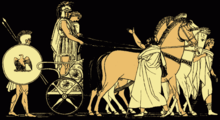
In legend, Atreus had two sons, Agamemnon and Menelaus, the Atreids. Aegisthus, the son of Thyestes, killed Atreus and restored Thyestes to the throne. With the help of King Tyndareus of Sparta, the Atreids drove Thyestes again into exile. Tyndareus had two ill-starred daughters, Helen and Clytemnestra, whom Menelaus and Agamemnon married, respectively. Agamemnon inherited Mycenae and Menelaus became king of Sparta.
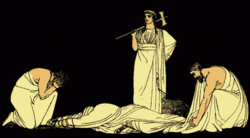
Homeric Poems
Soon, Helen eloped with Paris of Troy. Agamemnon conducted a 10-year war against Troy to get her back for his brother. Because of lack of wind, the warships could not sail to Troy. In order to please the gods so that they might make the winds start to blow, Agamemnon sacrificed his daughter Iphigenia. According to some versions of the legend, the hunting goddess Artemis replaced her at the very last moment with a deer on the altar, and took Iphigenia to Tauris (see Iphigenia in Tauris by Euripides). The deities, having been satisfied by such a sacrifice, made the winds blow and the Greek fleet departed.
Legend tells us that the long and arduous Trojan War, although nominally a Greek victory, brought anarchy, piracy, and ruin; already before the Greek fleet set sail for Troy, the conflict had divided the gods as well, and this contributed to curses and acts of vengeance following many of the Greek heroes. After the war Agamemnon returned to Mycenae and was greeted royally with a red carpet rolled out for him. Shortly thereafter, he was slain by Clytemnestra, who hated him bitterly for having ordered the sacrifice of their daughter Iphigenia in order to gain favorable winds to Troy. Clytemnestra was aided in her crime by Aegistheus, her lover, who reigned subsequently, but Orestes, her son by Agamemnon, was smuggled out to Phocis. He returned as an adult with his sister Electra to slay Clytemnestra and Aegistheus. He then fled to Athens to evade justice and a matricide, and became insane for a time. Meanwhile, the throne of Mycenae went to Aletes, son of Aegistheus, but not for long. Recovering, Orestes returned to Mycenae with Electra to kill Aletes and took the throne. This story is told in numerous plays, including the Oresteia, Sophocles' Electra, and Euripides' Electra.
End of the Atreids
Orestes then built a larger state in the Peloponnese, but he died in Arcadia from a snake bite. His son, Tisamenus, the last of the Atreid dynasty, was killed by the Heracleidae on their return to the Peloponnesus. They claimed the right of the Perseids to inherit the various kingdoms of the Peloponnese and cast lots for the dominion of them. Whatever the historical realities reflected in these stories, the Atreids are firmly set in the epoch near the end of the Heroic Age, leading up to the arrival of the Dorians. There are no established stories of a royal house at Mycenae later than the Atreids, and this could reflect the fact that not much more than fifty or sixty years seem to have separated the fall of Troy VIIa (the likely inspiration of Homeric Troy) and the fall of Mycenae.
Records in Asia Minor

On March 5, 1223 BC, there was a total eclipse of the sun in the Aegean, which Atreus might have twisted into a setting of the sun in the east. However, this date does not solve all unknowns.
A late date is implied for the Trojan War, which would, in that case, have been against Troy VIIa after all. The Perseids would have been in power circa 1380 BC, the date of a statue base from Kom el-Heitan in Egypt recording the itinerary of an Egyptian embassy to the Aegean in the time of Amenhotep III (r. 1391–1353 BC or 1388–1351 BC). M-w-k-i-n-u (phonetic "Mukanuh") was one of the cities visited, a rare early document of the name of Mycenae. It was one of the cities of the tj-n3-jj ("Tinay"),[61] The Homeric Danaans were named, in myth, after Danaë, which suggests that the Perseids were in fact in some sort of dominion.
Also in the 14th century BC, Ahhiya began to be troublesome to numerous kings of the Hittite Empire. Ahhiyawa or Ahhiya, which occurs a few dozen times in Hittite tablets over the century, is probably Achaiwia, reconstructed Mycenaean Greek for Achaea. The Hittites did not use "Danaja" as did the Egyptians, even though the first Ahhiya reference in the "Indictment of Madduwatta"[62] precedes the correspondence between Amenhotep III and one of Madduwatta's subsequent successors in Arzawa, Tarhunta-Radu. There are no indications in the external sources for an overarching authority, such as a great king, or another unifying structure behind Ahhiya and the Tinay, at this (LHIIIA:1) time, though the Egyptian sources do seem to suggest that Tinay was a single ‘country’ (much like Keftiu - Crete).
For example, in the "Indictment of Madduwatta", Attarsiya, the "ruler of Ahhiya", attacks Madduwatta and drives him from his land. He obtains refuge and military assistance from the King Tudhaliya of the Hittites.[62] After the death of the latter and in the reign of his son, Arnuwanda, Madduwatta allies with Attarissiya and they, along with another ruler, raid Alasiya, that is, Cyprus.[63]
This is the only known occurrence of a man named Attarissiya, and indeed the only secure attestation of any royal Mycenaean name in the Hittite texts (though a brother of the king of Ahhiyawa is named in a later text; see below). Attempts to link this name to Atreus have not resulted in scholarly consensus. The eminent scholar Martin West suggested, however, that the name Atreus may be a shortened derivate from an earlier, Mycenaean name (possibly Atresias) that was similar to Attarissiya.[64] Alternatively, Albrecht Goetze proposed that Attarissiya may be compared to the Homeric possessive Atreid; used to designate both Menelaos and Agamemnon as "sons of Atreus."[65]
During LHIIIA:2, Ahhiya, now known as Ahhiyawa, extended its influence over Miletus, settling on the coast of Anatolia, and competed with the Hittites for influence and control in western Anatolia. For instance, Uhha-Ziti's Arzawa and through him Manapa-Tarhunta's Seha River Land. While establishing the credibility of the Mycenaean Greeks as a historical power, these documents create as many problems as they solve.
Similarly, a Hittite king wrote the so-called Tawagalawa Letter to the Great King of Ahhiyawa, concerning the depredations of the Luwiyan adventurer Piyama-Radu. Neither of the names of the great kings are stated; the Hittite king could be either Muwatalli II or his brother Hattusili III, which at least dates the letter to LHIIIB by Mycenaean standards. The fact that the King of Ahhiyawa is addressed as a "Royal Brother" and designated as a "Great King", however, is striking, for only few ancient monarchs were accorded this honorific title.[66] This Ahhiyawan Great King remains unfortunately unnamed. His brother, however, is named in this text, as Tawagalawa; which may have been the Hittite rendering of *Etewoclewes (Eteocles). But neither the Atreus nor the Agamemnon of legend have any brothers named *Etewoclewes (Eteocles); this name, rather, is associated with Thebes. Intriguingly, though the region around Thebes (the Thebaid) may be listed, as Tqs, in the Kom el Hetan text (dating to Amenhotep III),the town itself is not (compare to Mycenae, which is specifically mentioned in that very same text).
Excavation
_NAMA_Tablette_7671.jpg)
The first excavations at Mycenae were carried out by Greek archaeologist Kyriakos Pittakis in 1841 where he found and restored the Lion Gate.[67] In 1874, Heinrich Schliemann excavated deep shafts all over the acropolis without permission; in August 1876, a complete excavation of the site by Schliemann commenced with the permission of the Archaeological Society of Athens (ASA) and the supervision of one of its members, Panayiotis Stamatakis.[67] Schliemann believed in the historical truth of the Homeric stories and interpreted the site accordingly. He found the ancient shaft graves with their royal skeletons and spectacular grave goods. Upon discovering a human skull beneath a gold death mask in one of the tombs, he declared: "I have gazed upon the face of Agamemnon".[68]
Since Schliemann's day, more scientific excavations have taken place at Mycenae, mainly by Greek archaeologists but also by the British School at Athens. Christos Tsountas, another member of the ASA, cleared a significant portion of the citadel during his excavations of the site beginning in 1884 and ending in 1902.[67] The Athens Archaeological Society is currently excavating the Mycenae Lower Town (as of 2011), with support from Dickinson College and the Institute for Aegean Prehistory.[69] Afterwards, Tsountas and the ASA gave permission to the British School of Archaeology (BSA) to excavate; the BSA conducted excavations from 1920 to 1955 under the supervision of Alan John Bayard Wace, assisted by Winifred Lamb.[67] In 1951, workers discovered Grave Circle B. After Wace died in 1957, excavation work was finished by Lord William Taylor from 1958 to 1969, especially on the west slope of the citadel.[67] The ASA continued excavation work on the site with efforts led by Ioannis Papadimitriou and Nicolas Verdelis in the late 1950s and early 1960s, as well as by George Mylonas from 1957 up until 1985.[67] In 1985, excavation work was directed by Spyros Iakovidis who, as of 2009, is still overseeing the ASA's research mission in both fieldwork and publication preparation.[67]
See also
- List of ancient Greek cities
- Boar's tusk helmet
- Fortification of Mycenae
- Gold Grave Goods at Grave Circles A and B
- National Archaeological Museum of Athens
References
Citations
- "Mycenae, Citadel (Building)".
- https://www.dictionary.com/browse/mycenae
- Bury and Meiggs 1975, p. 20
- Chew 2000, p. 220; Chapman 2005, p. 94: "...Thebes at 50 hectares, Mycenae at 32 hectares..."
- Beaudouin 1880, pp. 206–210.
- Pausanias. Description of Greece, 2.16.5.
- Blakolmer 2010, p. 50: "Thus it is no wonder that the Lion Gate attracted the attention of European scholars who visited this prominent city-gate in the Argolid - a region constituting not only a focal point of antiquity but also the heart-land of early modern Greece and thus presenting good preconditions for foreign travellers and scholars in the 19th century. Mycenae's first identification by a European traveller was by M. de Monceaux in 1669, while the first mention of the Lion Gate is due to the Venetian engineer Francesco Vandeyk in 1700." [Note: The interpretation of the 1669 visit is contradicted by Moore, Rowlands & Karadimas 2014 where de Monceaux had not visited Mycenae, having mistakenly identified an acropolis as Mycenae on his travels to Tiryns.]
- Moore, Rowlands & Karadimas 2014, p. 4: "The first modern, correct, identification of Mycenae seems to have been made in 1700, when the government of Venice ordered Francesco Grimani, Proveditor General of the Armies in Morea, to register all their properties in the Peloponnese. The record was completed under the direction of the engineer, Francesco Vandeyk, who not only made detailed plans for each village, but also studied and described ancient monuments. Among them was the ancient site of Mycenae which he was able to identify on the basis of Pausanias' description. Vandeyk reported a monumental entrance where a triangular relief was sculpted with two lions disposed heraldically against a column. He noted that these lions stepped their forepaws on two altars and, as a result, the entrance is known today as the Lion Gate. Indeed, Pausanias' own description of the Lion Gate was so accurate that it did not leave any doubt that the monumental acropolis, close to the modem village of Charvati, was the site identified by the ancient author as Agamemnon's citadel."
- Homer. Iliad, 4.52, 7.180, 11.46
- Pausanias. Description of Greece, 2.16.3.
- Shelton 2010, p. 58.
- Bury and Meiggs 1975, p. 22
- Forsén 1992, "Mycenae – Argolid (A:5)", pp. 51–52.
- Velikovsky 1999, Edwin M. Schorr, "Applying the Revised Chronology: Later Use of Grave Circles".
- Komita 1982, pp. 59–60.
- French 2002, p. 56.
- An older view that it represents a goddess, now generally discounted, is to be found in W.K.C. Guthrie, in The Cambridge Ancient History (1975) Volume I, Part II, p. 864: "A frequent design on engraved Cretan gems is of the type made famous by the Lion Gate at Mycenae, a single upright pillar, flanked by a pair of guardian animals. Sometimes the same arrangement is preserved, but the anthropomorphic figure of a god or goddess takes the place of a pillar" (illustrations from Nilsson). More recent discussions of its symbolism can be found in James C. Wright, "The Spatial Configuration of Belief: The Archaeology of Mycenaean Religion" in S.E. Alcock and Robin Osborne (eds.), Placing the Gods, Oxford University Press, 1996, pp. 37–78. Here Wright suggests that the pillar represents the palace which in turn represents the state.
- Castleden 2005, pp. 95–96; French 2002; Luce 1975, p. 35: "The Lion Gate provides further testimony to the power of the Pelopids, for Mylonas appears to have shown conclusively that it dates from c. 1250. With the stretch of Cyclopean wall enclosing Grave Circle A it represents the climax of military and monumental construction."
- Scarre 1999.
- "Mycenae, Citadel (Building)". www.perseus.tufts.edu. Retrieved 2018-07-07.
- Vermeule 1960, p. 67.
- Mylonas 1966, pp. 230–231.
- Drake 2012, pp. 1862–1870; Kaniewski et al. 2010, pp. 207–215.
- Andronikos 1954, pp. 221–240.
- Desborough 1975, pp. 658–677.
- Mylonas 1966, p. 232.
- Nur 2008, Chapter 8: Earthquake Storms and the Catastrophic End of the Bronze Age, pp. 224–245.
- French 2002, p. 142: "The dedications continue at the Shrine by the Bridge into the fifth century, probably beyond the disablement of the walls by the Argives in 468 BC."
- French 2002, pp. 19, 146–150.
- Chadwick 1976, pp. 70–77.
- Dietrich p.65–66"
- Mylonas 1966, pp. 206–208.
- Chadwick 1976, pp. 71–72.
- δοῦλος. Liddell, Henry George; Scott, Robert; A Greek–English Lexicon at the Perseus Project
- Chadwick 1976, Chapter 5: Social Structure and Administrative System, pp. 69–83.
- Kelder 2010 p.34
- Kelder2010 p,.97
- Kelder 2010 p.119
- Finley 1954, p. 124.
- Nilsson 1967, Volume I, p. 339.
- Page 1976, "IV: The Homeric Description of Mycenaean Greece", pp. 118–177 (see especially pp. 122–123).
- Dietrich 1973, pp. 65–66.
- Paul, Adams John (10 January 2010). "Mycenaean Divinities". Northridge, CA: California State University. Retrieved 24 January 2014.
- Nilsson 1967, Volume I, pp. 479–480.
- Kerényi 1976, pp. 110–114; Nilsson 1967, Volume I, pp. 315–319. The child dies every year in order to be reborn. In the Minoan myth it is abandoned by his mother, and then brought up by the powers of nature. Similar myths are found in the cults of Hyakinthos (Amyklai), Erichthonios (Athens), Ploutos (Eleusis), and in the cult of Dionysos.
- Burkert 1987, p. 21.
- Hornblower, Spawforth & Eidinow 2012, "Artemis", pp. 175–176.
- Poseidon is pairing with the "Two Goddesses" (Demeter and Persephone) in Linear B tablets. There is a theory linking his name with elements meaning "husband" or "lord" (Greek πόσις (posis), from PIE *pótis) and another element meaning "earth" (δᾶ (da), Doric for γῆ (gē)), producing something like lord or spouse of Da, i.e. of the earth. His name may also be interpreted as "lord of the waters" (from PIE *potis and Sanskr. daFon: "water").
- Walcot 1966, p. 85f.; Jeffrey 1976, p. 38; M.L. West (Early Greek Philosophy and the Orient, 1971, p. 205) holds that such eastern material is more likely to be lingering traces from the Mycenaean tradition than the result of Oriental contacts in Hesiod's own time.
- Hesiod. Theogony, Lines 216–224: "Also she bore the Destinies and ruthless avenging Fates, Clotho and Lachesis and Atropos, who give men at their birth both evil and good to have, and they pursue the transgressions of men and of gods: and these goddesses never cease from their dread anger until they punish the sinner with a sore penalty."
- Nilsson 1967, Volume I, p. 368: "Moira is not a god, because otherwise the will of the god would be predestinated. Compare Kismet in Muslim religion."
- Aeschylus. Prometheus Bound, Lines 515–518.
- Schachermeyer 1964, p. 128.
- Schachermeyer 1964, p. 241.
- Schachermeyer 1964, p. 141. Elysion may be affiliated with Eleusis, the city of the Eleusinian Mysteries.
- Helbig 1884, p. 53; Wunderlich 1974, p. 221.
- Wunderlich 1974, pp. 216–218, 221–222.
- Hesiod. Theogony, Lines 535–544.
- Pindar. Pythionikos, VIII.95–7: "Man's life is a day. What is he, what is he not? A shadow in a dream is man, but when God sheds a brightness, shining light is on earth and life is sweet as honey."
- For a fuller discussion of this statue base, the names on it and the pronunciation, Tinay, which appears related to Danaj-, see Documentary and Archaeological Evidence of Minoan Trade.
- Beckman, Bryce & Cline 2012, "Introduction", p. 5.
- Popko 2008, pp. 121–122.
- West 2001, pp. 262–266.
- Sweeney 2009, pp. 101–102.
- Kelder, Jorrit (2020). "A Great King and a Wanax? The Politics of Mycenaean Greece". The Ancient Near East Today: Current News about the Ancient Past. American Schools of Oriental Research.
- Gagarin 2010, "Mycenae: Archaeology of Mycenae", pp. 24–26.
- Schliemann 1878.
- Dickinson Excavation Project and Archaeological Survey. "Mycenae – Beyond the Walls of Agamemnon: Excavation of the Mycenae Lower Town (2007–2011)". Retrieved 25 January 2014.
Sources
- Andronikos, Manolis (1954). Η 'Δωρική Εισβολή' και τα Αρχαιολογικά Ευρήματα. Hellenika (in Greek). 13: 221–240.CS1 maint: ref=harv (link)
- Beaudouin, Mondry (1880). "Fragments d'une description de l'Argolide faite en 1700 par un ingénieur italien". Bulletin de Correspondance Hellénique. 4: 206–210. doi:10.3406/bch.1880.4318.CS1 maint: ref=harv (link)
- Beckman, Gary M.; Bryce, Trevor R.; Cline, Eric H. (2012). Writings from the Ancient World: The Ahhiyawa Texts (PDF). Atlanta: Society of Biblical Literature. ISSN 1570-7008.CS1 maint: ref=harv (link)
- Beekes, Robert Stephen Paul (2009). Etymological Dictionary of Greek. Leiden and Boston: Brill. ISBN 978-9-00-417418-4.CS1 maint: ref=harv (link)
- Blakolmer, Fritz (2010). "Images and Perceptions of the Lion Gate Relief at Mycenae during the 19th Century". In F. Buscemi (ed.). The Representation of Ancient Architecture in the XIXth Century. Cogitata. pp. 49–66.CS1 maint: ref=harv (link)
- Burkert, Walter (1987) [1985]. Greek Religion: Archaic and Classical. Oxford and Malden: Blackwell Publishing Limited. ISBN 978-1-11-872499-6.CS1 maint: ref=harv (link)
- Bury, J. B.; Meiggs, Russell (1975). A History of Greece (Fourth ed.). London: MacMillan Press. ISBN 978-0-333-15492-2.CS1 maint: ref=harv (link)
- Castleden, Rodney (2005). The Mycenaeans. London and New York: Routledge. ISBN 978-0-415-36336-5.CS1 maint: ref=harv (link)
- Chadwick, John (1976). The Mycenaean World. Cambridge, UK: Cambridge University Press. ISBN 978-0-521-29037-1.CS1 maint: ref=harv (link)
- Chapman, Robert (2005). "Changing Social Relations in the Mediterranean Copper and Bronze Ages". In Blake, Emma; Knapp, A. Bernard (eds.). The Archaeology of Mediterranean Prehistory. Oxford and Malden: Blackwell Publishing. pp. 77–101. ISBN 978-1-40-513724-9.CS1 maint: ref=harv (link)
- Chew, Sing C. (2000). "Neglecting Nature: World Accumulation and Core-Periphery Relations, 2500 BC to AD 1990". In Denemark, Robert A. (ed.). World-System History: The Social Science of Long-Term Change. London and New York: Routledge. pp. 216–234.CS1 maint: ref=harv (link)
- Desborough, V. (1975). "The End of Myceanean Civilization and the Dark Ages: The Archaeological Background". In Edwards, I.E.S.; Gadd, C.J.; Hammond, N.G.L.; et al. (eds.). The Cambridge Ancient History II (2). Cambridge: Cambridge University Press. pp. 658–677.CS1 maint: ref=harv (link)
- Dietrich, Bernard Clive (1973). The Origins of Greek Religion. Berlin: Walter de Gruyter. ISBN 978-3-11-003982-5.CS1 maint: ref=harv (link)
- Drake, Brandon L. (2012). "The influence of climatic change on the Late Bronze Age collapse and the Greek dark ages". Journal of Archaeological Science. 39 (6): 1862–1870. doi:10.1016/j.jas.2012.01.029.CS1 maint: ref=harv (link)
- Finley, Moses I. (1954). The World of Odysseus. New York, NY: New York Review Books. ISBN 978-1-59-017017-5.CS1 maint: ref=harv (link)
- Forsén, Jeannette (1992). The Twilight of the Early Helladics. Partille, Sweden: Paul Aströms Förlag. ISBN 978-91-7081-031-2.CS1 maint: ref=harv (link)
- French, Elizabeth Bayard (2002). Mycenae: Agamemnon's Capital. Stroud: Tempus. ISBN 978-0-7524-1951-0.CS1 maint: ref=harv (link)
- Gagarin, Michael, ed. (2010). The Oxford Encyclopedia of Ancient Greece and Rome. 1. New York and Oxford: Oxford University Press. ISBN 978-0-19-517072-6.CS1 maint: ref=harv (link)
- Helbig, Wolfgang (1884). Das Homerische Epos aus den Denkmälern Erläutert (in German). Leipzig: B.G. Teubner.CS1 maint: ref=harv (link)
- Hornblower, Simon; Spawforth, Antony; Eidinow, Esther (2012) [1949]. The Oxford Classical Dictionary (4th ed.). Oxford: Oxford University Press. ISBN 978-0-19-954556-8.CS1 maint: ref=harv (link)
- Jeffrey, L.H. (1976). Archaic Greece: The City-States c. 700–500 BC. London: Ernest Benn. ISBN 978-0-510-03271-5.CS1 maint: ref=harv (link)
- Kaniewski, David; Paulissen, Etienne; van Campo, Élise; Weiss, Harvey; Otto, Thierry; Bretschneider, Joachim; van Lerberghe, Karel (2010). "Late second–early first millennium BC abrupt climate changes in coastal Syria and their possible significance for the history of the Eastern Mediterranean". Quaternary Research. 74 (2): 207–215. Bibcode:2010QuRes..74..207K. doi:10.1016/j.yqres.2010.07.010.CS1 maint: ref=harv (link)
- Kelder, Jorrit M. (2010). The Kingdom of Mycenae: A Great Kingdom in the Late Bronze Age Aegean. Bethesda, MD: CDL Press. Retrieved 18 March 2015.CS1 maint: ref=harv (link)
- Kerényi, Karl (1976). Dionysus: Archetypal Image of Indestructible Life. Princeton, NJ: Princeton University Press. ISBN 978-0-69-102915-3.CS1 maint: ref=harv (link)
- Komita, Nobuo (1982). "The Grave Circles at Mycenae and the Early Indo-Europeans" (PDF). Research Reports of Ikutoku Technical University (A-7): 59–70.CS1 maint: ref=harv (link)
- Luce, John Victor (1975). Homer and the Heroic Age. New York: Harper & Row. ISBN 978-0-06-012722-0.CS1 maint: ref=harv (link)
- Moore, Dudley; Rowlands, Edward; Karadimas, Nektarios (2014). In Search of Agamemnon: Early Travellers to Mycenae. Newcastle upon Tyne: Cambridge Scholars Publishing. ISBN 978-1-4438-5776-5.CS1 maint: ref=harv (link)
- Mylonas, George Emmanuel (1966). Mycenae and the Mycenaean Age. Princeton, NJ: Princeton University Press.CS1 maint: ref=harv (link)
- Nilsson, Martin Persson (1967). Geschichte der Griechischen Religion (in German) (3rd ed.). Munich: C.H. Beck Verlag.CS1 maint: ref=harv (link)
- Nur, Amos (2008). Apocalypse: Earthquakes, Archaeology and the Wrath of God. Princeton, NJ: Princeton University Press. ISBN 978-0-69-101602-3.CS1 maint: ref=harv (link)
- Page, Denys Lionel (1976) [1959]. History and the Homeric Iliad. Berkeley and Los Angeles: University of California Press. ISBN 978-0-52-003246-0.CS1 maint: ref=harv (link)
- Popko, Maciej (2008). Völker und Sprachen Altanatoliens (in German). Wiesbaden: Otto Harrassowitz Verlag. ISBN 978-3-447-05708-0.CS1 maint: ref=harv (link)
- Scarre, Christopher (1999). The Seventy Wonders of the Ancient World: The Great Monuments and How They Were Built. London: Thames and Hudson. ISBN 978-0-50-005096-5.CS1 maint: ref=harv (link)
- Schachermeyer, Fritz (1964). Die Minoische Kultur des alten Kreta. Stuttgart: Kohlhammer Verlag.CS1 maint: ref=harv (link)
- Schliemann, Heinrich (1878). Mykena (in German). Leipzig.CS1 maint: ref=harv (link)
- Shelton, Kim S. (2010). "Living and Dying in and Around Middle Helladic Mycenae". In Philippa-Touchais, Anna; Touchais, Gilles; Voutsaki, Sofia; et al. (eds.). MESOHELLADIKA: The Greek Mainland in the Middle Bronze Age (Bulletin de Correspondance Hellénique: Supplément, Volume 52). Athens: École française d’Athènes. pp. 57–65. ISBN 978-2-86958-210-1.CS1 maint: ref=harv (link)
- Sweeney, Emmet John (2009). Gods, Heroes and Tyrants: Greek Chronology in Chaos. New York: Algora Publishing. ISBN 978-0-87586-683-3.CS1 maint: ref=harv (link)
- Velikovsky, Immanuel (1999). The Dark Age of Greece. Shulamit V. Kogan & Ruth V. Sharon.CS1 maint: ref=harv (link)
- Vermeule, Emily Townsend (March 1960). "The Fall of the Mycenaean Empire". Archaeology. 13 (1): 66–76. JSTOR 41663738.CS1 maint: ref=harv (link)
- Walcot, Peter (1966). Hesiod and the Near East. Wales: University of Wales Press.CS1 maint: ref=harv (link)
- West, Martin L. (2001). "Atreus and Attarissiyas". Glotta. Vandenhoeck & Ruprecht (GmbH & Co. KG). 77 (3/4): 262–266. JSTOR 40267129.CS1 maint: ref=harv (link)
- Wunderlich, Hans Georg (1974). The Secret of Crete. New York: Macmillan Publishing Company, Incorporated. ISBN 978-0-02-631600-2.CS1 maint: ref=harv (link)
Further reading
- Bryson, Reid; Murray, Thomas J. (1977). Climates of Hunger: Mankind and the World's Changing Weather. Madison, WI: University of Wisconsin Press. ISBN 978-0-29-907373-2.
- Finley, Moses I. (1970). Early Greece: The Bronze and Archaic Ages. London: Chatto & Windus.
- Hooker, Richard (1996). "Mycenean Religion". Barbarians and Bureaucrats. Washington State University. Archived from the original on 1 February 2014. Retrieved 25 January 2014.
- Jansen, Anton (1997). "Bronze Age Highways at Mycenae". Classical Views. XLI (16): 1–16. Archived from the original on November 23, 2007.CS1 maint: unfit url (link)
- Mylonas, George Emmanuel (1968). Mycenae's Last Century of Greatness. Sydney: Sydney University Press for Australian Humanities Research Council.
- Mylonas, George E. (1983). Mycenae Rich in Gold. Athens: Ekdotike Athenon.
- Nilsson, Martin Persson (1972) [1932]. The Mycenaean Origin of Greek Mythology. Berkeley and Los Angeles: University of California Press. ISBN 978-0-52-002163-1.
- Palmer, Leonard R. (1965) [1961]. Mycenaeans and Minoans: Aegean Prehistory in the Light of the Linear B Tablets. Part I: Pylos and the World of the Tablets. Part II: Knossos and Aegean History (2nd ed.). London: Faber and Faber.
- Taylour, Lord William; French, Elizabeth Bayard; Wardle, K.A. (2007). Well Built Mycenae (Volume 13): The Helleno-British Excavations within the Citadel at Mycenae 1959-1969. Warminster, England: Aris & Phillips. ISBN 978-1-84-217295-7.CS1 maint: ref=harv (link)
- Vermeule, Emily (1964). Greece in the Bronze Age. Chicago: The University of Chicago Press.
- Wace, Alan John Bayard (1964) [1949]. Mycenae: An Archaeological History and Guide. New York: Biblio and Tannen.
- Wardle, K.A.; Wardle, Diana (1997). Cities of Legend: The Mycenaean World. London: Bristol Classical Press. ISBN 978-1-85-399355-8.CS1 maint: ref=harv (link)
External links
| Wikimedia Commons has media related to Mycenae. |
| Wikisource has the text of the 1911 Encyclopædia Britannica article Mycenae. |

